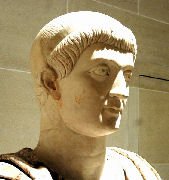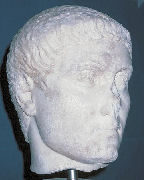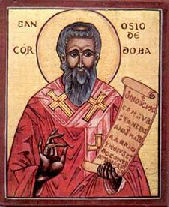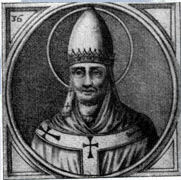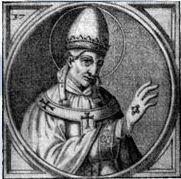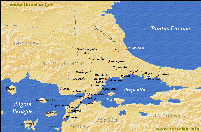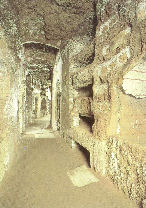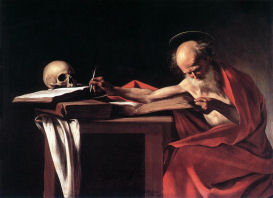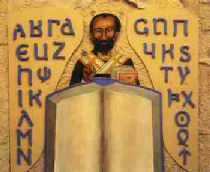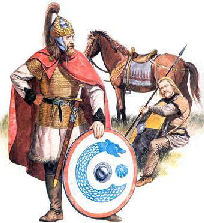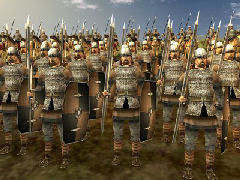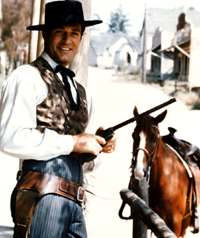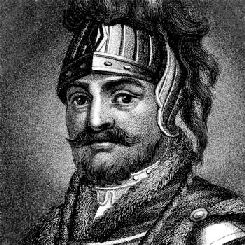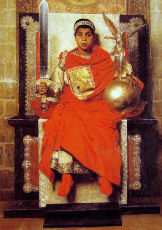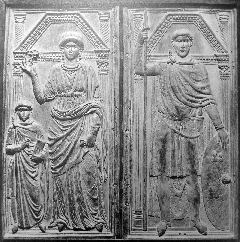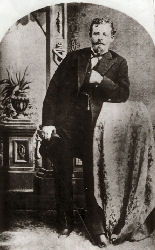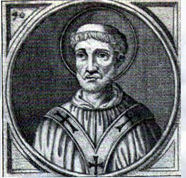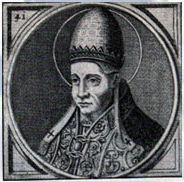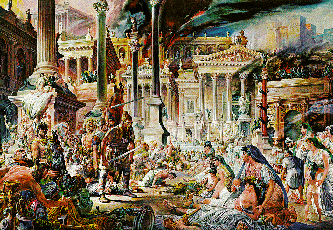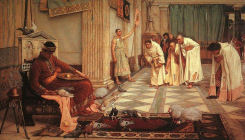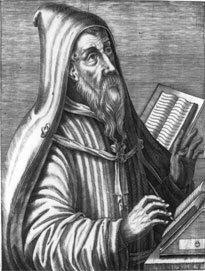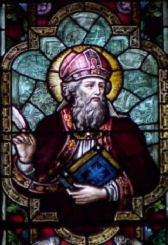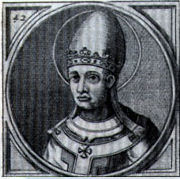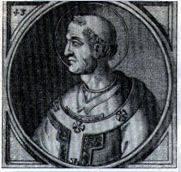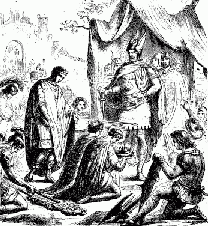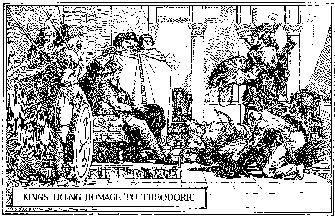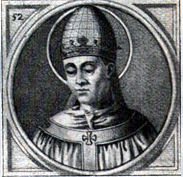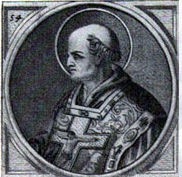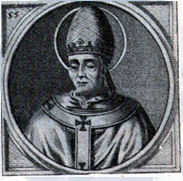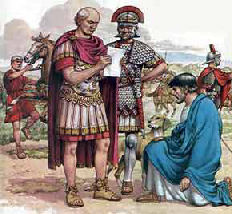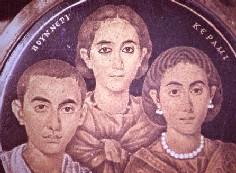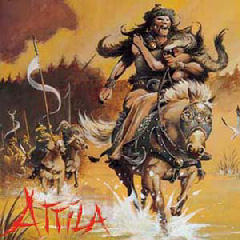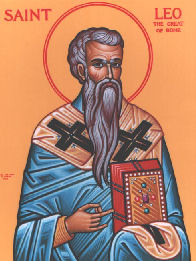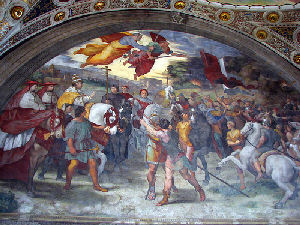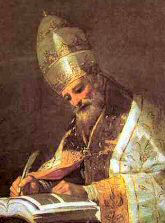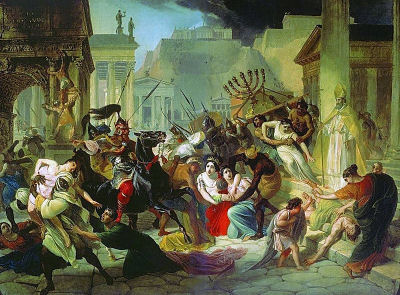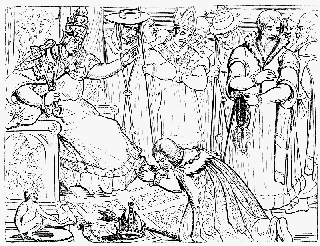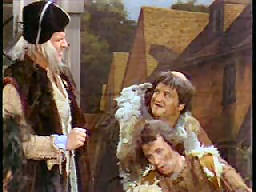Chapter 2: (Barb)Arians at the Gate
Many nuns lacked Sr. Mary Immaculata’s benevolent nature. For example, heartfelt prayers constantly emanated heavenward from the class overseen by Sr. Diocletia, the meanest of all of the Sisters of St. Ursula, and they all pleaded for a new teacher. One day they were answered; Sr. Diocletia came down with a severe illness. Her class probably hoped for a replacement as even-tempered as Sr. Mary Immaculata. Imagine the reaction when Sr. Torquemada, the school’s principal, told them that no one would be leading the class, and they were on their own for the rest of the year.
The Split Empire
To Roman Christians Constantine’s reign must have seemed like a new dawn signaling the end of imperial persecutions and the beginning of delicious religious freedom. The outlook of the Roman clergy – and especially the pope – was probably somewhat less sanguine. The emperors had departed Rome and would likely never return. Although they had often tormented the Christian community, they reliably safeguarded the city itself. The transfer of power from Rome to Constantinople betokened a dramatic turning point for both the city and the Church.
Picturing Roman life in the fourth century challenges the twenty-first century imagination. There are no ready visuals to draw on – no movies, no TV shows, not even any famous paintings. It was certainly nothing like Ben Hur or I, Claudius or Spartacus or Gladiator. Over the course of several centuries Romans had grown accustomed to being the focal point of the sprawling empire. The city maintained rather close economic ties with all corners of the civilized world. Goods and people migrated in and out. Tremendous advantages ensued, but one unintended consequence was exposure to new diseases. Horrendous plagues devastated Rome. From 252 to 267, for example, Romans perished by the thousands, probably from smallpox. The horror is difficult for a modern person to appreciate, but painful memories must still have haunted Romans in the 300’s.
Substantial economic changes affected nearly everyone. Constantine overhauled imperial fiscal policy. The loot from conquests no longer reverted to Rome. Constantinople had been officially designated the “New Rome.”[1] Wealth became concentrated in the east. Moreover, Rome suffered from a severe “brain drain.” A cadre of imperial administrative personnel – which must have included everyone of note – departed with the emperor. Rome still had history, many formidable stone and concrete structures, and the pope, but its losses were severe.
Constantine established new procedures for local administration within the Church. He decreed that the bishop of each major city was to be elected by its citizenry. If the emperor ratified the selection, neighboring bishops would perform the investiture ceremony. This process cleverly empowered everyone involved – the people selected their own religious leaders, the emperor kept everyone under his thumb, and the bishops represented the Church. That the pope had no say whatever will shock all of my classmates who learned from Sr. Mary Immaculata that Rome had the last word on all Church decisions.
Constantine never named a successor. The bloody civil war following his death culminated in a division of power between his two surviving sons along geographical lines. Constantius II, an Arian, ran the east from Constantinople. The orthodox Christian Constans ruled the western half from Milan.Throughout the fourth century the east openly flouted papal authority. No event exemplified this more than the struggle over Bishop Athanasius, the star of the Council of Nicea of 325. In the ensuing decade he became the Bishop of Alexandria, one of the five patriarchs. After their stunning defeat at Nicea the Arians plotted to expand their influence in the Church. Through the rest of Constantine’s reign they employed all their wiles to regain control, and they most often prevailed in the east. In 335, two years before Constantine’s death, Arians persuaded the emperor that Athanasius was a rebellious troublemaker. He was deposed, excommunicated, and exiled to Gaul along with many supporters.
Pope Julius I, however, accepted Athanasius into communion and called a council of bishops to resolve the controversy. The eastern bishops protested that Julius had no right to allow an excommunicated heretic to receive communion. They challenged papal authority and even reminded Christianity that Sts. Peter and Paul had traveled to Rome from churches previously established in the east. They brazenly issued the pope an ultimatum – side with the heretic or side with the eastern Church. Because Rome largely depended upon the generosity of the empire administered from Constantinople, Julius surely took the threats of the eastern bishops seriously. Sr. Mary Immaculata, however, knew in her heart that the pope would never cave, and she was right about Pope Julius.
The two emperors jointly convoked a council to settle the matter in 343 at Sardica (Sophia, Bulgaria). It was chaired by the same Bishop Hosius whose name appears atop the signers of Nicea. Eighty western bishops and as many easterners attended. When the latter spotted Athanasius seated among the western bishops, they refused to enter the council chamber. Instead they convened their own council in Philippopolis, and they excommunicated Athanasius (again), Hosius, and Julius I, who became the first pope to be excommunicated from his own Church.The western bishops retaliated by excommunicating the heads of the eastern Church. If all of these excommunications were valid, the Church would have been essentially leaderless. Fortunately, neither side heeded the other’s actions.
Everyone in Sr. Mary Immaculata’s class knew when a door was not a door, but when is an excommunication not an excommunication? It is a good thing that the dispute over Athanasius was never in our lesson plan. Even S’ter might have been stumped by that riddle.
The Council of Sardica passed a series of canons specifying the Bishop of Rome as the head of the Church. Although the papacy still had a ways to go before the pope was universally considered il capo di tutti capi, these canons would be potent weaponry for repulsing future assaults.
Liberius’s Disappearing Act
After Sardica the eastern Church seemed beyond papal influence. On the other hand, as long as Constans ruled in Milan, and Julius I was pope, the west was relatively stable. Unfortunately, the emperor’s demise in 350 left both halves of the empire in the hands of his Arian brother. When Pope Julius died in 352, he was succeeded by Liberius, the first pope denied sainthood. Don’t look for him in the Diplomatic Hall of Fame either.
Liberius soon found himself lobbied by the (excommunicated!) eastern bishops to condemn Athanasius. He asked Emperor Constantius, himself a prominent Arian, to convene a council to affirm the Nicene doctrines condemning Arianism. Instead, Constantius called two synods of his own. After he made the attending bishops an offer that they could not refuse, the attendees at both synods dutifully condemned Athanasius as a heretic. Even the pontiff’s own legates ignominiously capitulated. The few dissenting bishops faced exile.Pope Liberius found himself on an island. After he disavowed his legates to the synods, he rebuffed the emperor’s overtures and returned his gifts. He refused the emperor’s gifts! He asserted that accepting them would be equivalent to Judas’s pocketing of the thirty pieces of silver. His letter to the emperor referred to himself as the defender of the faith and the heir of the great tradition of Christian martyrs.
This response received a big thumbs down in Constantinople. In 355 Constantius took Liberius up on his implicit offer of martyrdom. He had the pope arrested and frog-marched up to Milan to stand trial. Before the proceedings could start, the emperor classified the pope as an “enemy combatant” and ordered him hauled off to the GTMO of the day, which was Thrace – southern Bulgaria and the strip of land at the north end of the Aegean Sea in which Greece abuts modern Turkey. There Arian clergy tried to convince Pope Liberius to support Arianism. Camera-phones were banned in Thrace, so we don’t know whether they waterboarded the pontiff or simply sicced vicious dogs on him.The pope was the spiritual leader of most of Europe and northern Africa, and he wielded considerable political influence in Rome and its surroundings. Liberius’s absence from the city created a power vacuum. Emperor Constantius thoughtfully installed a replacement, Felix II, the third antipope. Felix was officially listed as a saint. The records were not too reliable then; historians occasionally confused ancient people with similar names. Perhaps a Church historian mistook the emperor’s lapdog Felix for the saintly and meticulous photographer Felix Unger (“portraits a specialty”), who, in fact, did not appear until considerably later.
Meanwhile Liberius eventually yielded to the pressure. He validated Athanasius’s excommunication, and he signed a document contradicting the Nicene Creed. When Liberius returned to Rome in 358, Constantius proposed that he and Felix be co-popes. The Roman citizenry nixed the idea of the Church being run by such an odd couple. Most people forgave and wholeheartedly supported Pope Liberius, who devoted the rest of his pontificate to undoing the damage resulting from his actions in exile. St. Felix withdrew and built a church on the outskirts of Rome. Perhaps the road to sainthood sometimes coincides with the path of least resistance. The nuns never put it that way, but they often emphasized the importance of staying in line and keeping one’s mouth shut.
Pope Damasus I was elected in 366 in a contentious contest. He had collaborated with Felix, and many Romans chafed at the selection of this turncoat. The loser, Ursinus, was installed as Bishop of Rome by his supporters. He is considered the fourth antipope. Unlike the first three, Ursinus was quickly driven from office, or anti-office. He fled from Rome just before the city police joined bloodthirsty civilians in massacring 137 of his supporters trapped inside the Liberian Basilica. Ursinus eventually revoked his claim.
Nobody would have dared ask Sr. Mary Immaculata whether Damasus would still be considered a legitimate pope if his supporters had been on the receiving end of the slaughter. That kind of query could earn a guy[2] an immediate trip to Sr. Torquemada’s office. Over its door was penned, “Lasciate ogne speranza, voi ch'intrate.”Fortunately for Pope Damasus, the Arian emperor Constantius II died in 361 and was succeeded by a series of men without much interest in theology. In 381 a council in Constantinople called by Emperor Theodosius I, a fervent Christian, published a slightly modified creed that terminated the Arian debates, but the doctrine persisted.
St. Damasus was a well-known lady’s man. His nickname was “matronarum auriscapius,” which is Latin for “ear-tickler of the matrons.” These ladies lavished gifts on him. In those days “generously endowed” evidently had diverse connotations. The pontiff was even charged with adultery, but the Council of Aquileia acquitted him.
Damasus, more than his predecessors, strove to establish Roman preeminence. He called his fellow bishops “sons,” not brothers. They rewarded this slight by declaring in the council at Constantinople that disputes between bishops should be handled regionally, that is, not submitted to Rome.
Pope Damasus is generally credited with producing long-lasting effects on the Church in several areas:• He claimed that Peter was the first Bishop of Rome.
• The bones of hundreds of Christians were removed from the catacombs, broken into pieces, and put on the market for purchase by pilgrims. Sr. Mary Immaculata taught us about the catacombs, and we eventually learned about sacred relics, but we never put two and two together. S’ter’s evaluation that none of us was pope material was spot on.
• He transformed the pagan religious festival of Saturnalia into Christmas.
Claiming the Keys to the Kingdom
By 382 few Romans could read Greek. Pope Damasus’s most influential project, was the commissioning of St. Jerome to translate the Bible into Latin. His official Latin version would make the scriptures more accessible, but only to the clergy. Very few laymen were literate.
Proponents of papal preeminence had not previously cited scripture. They argued that Rome was the center of the civilized world and that its congregation was founded by the apostles Peter and Paul. Pope Damasus repeated these assertions, but by his era Rome’s influence had waned. Moreover, other patriarchates could advance persuasive cases for apostolic ties. The Bible clearly placed both St. Peter and Paul in Antioch, and Jerusalem was the site of numerous apostolic encounters. The pope needed a better argument.
St. Jerome’s translation, commonly known as the Vulgate, changed the debate. The popes came to rely on Jerome’s rendition of Jesus’s words in Matthew 16:18-19: “And I say also unto thee, that thou art Peter, and upon this rock I will build my church; and the gates of hell shall not prevail against it. And I will give unto thee the keys of the kingdom of heaven, and whatsoever thou shalt bind on earth shall be bound in heaven, and whatsoever thou shalt loose on earth shall be loosed in heaven.” Since the Vulgate’s publication, pontiffs have postulated that as Peter’s successors they alone have inherited absolute authority. Jerome’s wording is crucial to their reasoning. The verses are much more striking in his Latin than in the original Greek. In fact, Greek-speakers have never accepted the Roman interpretation at all. The dispute deserves careful consideration. However, since the barb(Arians) backstage are getting restless, this and related controversies have been relegated to Appendix 2.Growing Up Gothy
Although the Arian controversy had been settled, the doctrine had by no means been eradicated from Europe. During the heated dispute over Athanasius, a remarkable missionary named Ulfilas had converted many inhabitants of present-day Germany to the Arian version of the Christian message.
The wholesale demographic changes that occurred in western Europe in the fourth and fifth centuries dramatically influenced Church history. One Germanic tribe after another – the very peoples that Ulfilas had converted – migrated south into imperial territory and then interacted with the residents of the Roman empire. Inhabitants of Rome and Constantinople called them barbarians because they spoke their own gruff-sounding languages instead of the purportedly civilized tongues of Latin and Greek. The men sported beards and favored pants and boots over the togas and sandals that were the rage on the runways in Milan. They knew little about building aqueducts, paving roads, using cement, and fighting with disciplined military techniques. They were, however, good learners and fierce warriors. The fact that most were Arian Christians made them damnable heretics in the eyes of the popes. The less dogmatic emperors often considered them potential allies. One tribe, the Goths, had wrought havoc in the third century. They descended through modern Bulgaria and the Balkans into Greece. They even captured Athens and pillaged the Greek capital in 267 and 268. In the fourth century their territory extended all the way from the Black Sea to the Baltic. The Byzantines continually battled them, and imperial legions could boast only limited success at checking the Goths’ advances. In the 370’s the Goths divided into two groups. The “Ostrogoths” at that time inhabited the eastern section of the kingdom. The western area was controlled by the “Visigoths.” Both tribes had settled north of the Danube. In 376 the Visigoths signed a pact with Emperor Valens; it permitted them to settle in the imperial province of Moesia, which includes parts of modern Serbia and Bulgaria. The treaty eventually broke down due to the incredibly heartless treatment inflicted on the Visigoths by the Romans – the army fielded by the emperor in Constantinople. In the battle of Adrianople (in modern European Turkey near the Bulgarian border) in 378, the Visigoths defeated the Romans, and Emperor Valens was killed. This was not as much of a culture clash as one might expect. The Romans had always assimilated captured peoples into their ranks; substantial numbers of Germans, even Goths, fought alongside the Romans. Because the Goths habitually stripped fallen Romans of their arms and armor, the Gothic troops were nearly as well equipped. In addition, the ranks of the Visigoths were swollen with deserters from the Roman army. They brought their weapons, armor, and tactical knowledge with them. The Visigoths had also persuaded several other tribes into joining them, and their heavy cavalry proved decisive.The Visigoths failed to press their advantage after their victory. They lacked established supply lines and soon split up again in order to forage enough food to survive. Nevertheless, their threat was enough to persuade the orthodox Christian Emperor Theodosius I to make peace in 379. He even authorized the Visigoth army to act as the “Federati,” the emperor’s official army in the areas of Dacia and Thrace, strategic territories separating the west from the east. This act effectively established a Gothic state between the two empires.
Sr. Mary Immaculata’s class learned little or nothing about the Romans and the Visigoths, but we knew all about the westerns that dominated television. The nuns barred our six-shooters from school, but many of us toted them when we went anywhere else. Even the girls dressed up like Annie Oakley.S’ter could have explained the bizarre arrangement between the empire and the barbarians with an allusion to the more familiar gunfight at the O.K. Corral. Suppose that the Earps had lost the shootout; that Virgil, Morgan, and Doc Holliday had been killed; and that even Wyatt (brave, courageous, and bold) had been incapacitated. If John Clum, the mayor of Tombstone, had then deputized the Clanton and McLaury brothers, the situation would have roughly parallelled what happened after Adrianople. Few in Tombstone would have been optimistic about their future, especially when they discovered that the town fathers had neglected to pay the new lawmen.
In 395 the entire cast of characters changed. Alaric assumed the leadership of the Visigoths. Theodosius I died. His eighteen-year-old son Arcadius became emperor of the east. Honorius, who was all of eleven, ruled the west. This arrangement was a very bad idea.[3] In Constantinople the Praetorian Prefect Rufinus had the ear of Arcadius. Although Rufinus was not officially the young man’s regent, his influence over Arcadius made him the real power in the east. The story’s most romantic figure, Stilicho, was the son of a Vandal chief and a Roman woman. Theodosius had placed him in command of the western army, to which had been appended several legions of eastern troops. Stilicho, an Arian, became Emperor Theodosius’s strong right arm. On Theodosius’s death he was named regent for young master Honorius. Stilicho claimed that Theodosius had also asked him to protect Arcadius. Rufinus had reason to suspect that Stilicho had designs on the imperial throne for himself and/or his family. Stilicho’s relationship with Alaric dated back to when Alaric had commanded the auxiliaries for the empire.Alaric’s command began with an invasion of Thrace and Macedonia. Stilicho brought his army up to Thessaly and was on the point of engaging Alaric’s army in what promised to be a decisive battle. Stilicho, an extremely competent general, seemed to enjoy the upper hand. However, at the last minute Rufinus ordered him to deploy a large portion of the imperial force to Constantinople. Stilicho complied and let Alaric off the hook.
A Goth named Gainas[4] commanded the imperial troops dispatched to Constantinople. As soon as they arrived, they assassinated the hapless Rufinus. This confirms what Sr. Mary Immaculata told us many times: you should be very careful what you ask for.
Many in Constantinople blamed Stilicho for Rufinus’s murder. Thereafter the general kept his distance from the imperial capital. Stilicho defeated the Visigoths in 402 at Pollentia in northern Italy. Alaric escaped and left Italy. He returned in 403, but Stilicho defeated him again near Verona. The Visigoths withdrew from Italy, and again Alaric survived.
Some military historians look askance at Stilicho and Alaric’s long dance. Alaric may have set the world record for surviving the largest number of lost battles. In no other campaign was Stilicho so indecisive. He obliterated Gildo’s rebellion in Africa in 399. When the Ostrogoths invaded Italy in 405, Stilicho crushed them in Tuscany; the Ostrogoth army was decimated and its leader killed. Alaric, on the other hand, never won a battle against Stilicho, but after each defeat he either kept his army intact or rather quickly pieced it back together.
Perhaps Stilicho hoped to position his family to rule the western empire or maybe even both halves. He was certainly skilled at using marriage to promote his interests.• He himself married Serena, the niece and adopted daughter of Emperor Theodosius.
• Honorius, the western emperor, eventually married two of Stilicho’s daughters.
• Eucherius, Stilicho’s son, was betrothed to Galla Placidia, Honorius’s sister.
After Verona Stilicho negotiated a separate peace with Alaric. The latter assisted Stilicho in his campaign in Illyricum, which Stilicho considered to be a critical territory. Stilicho persuaded the Roman Senate to pay Alaric four thousand pounds of gold.Back to Tombstone for a minute. This time imagine that the Earps won the shootout without any problem, but Ike Clanton managed to survive when Wyatt inexplicably commanded his brothers to hold their fire. The marshal then deputized Ike and persuaded the townsfolk to turn over half of the contents of the Wells Fargo safe to him. Suspicious?
Stilicho’s world collapsed in 408. His army mutinied; many loyal supporters were murdered; some generals turned on him. He desperately sought sanctuary in a church in Ravenna. Honorius – twice Stilicho’s son-in-law – ordered his execution, and Stilicho was beheaded without a struggle. His son Eucherius was also murdered that year. Formerly renowned for their discipline, the leaderless imperial legions went on a rampage slaughtering Goths and other barbarians, even women and children. Backlash against the army triggered the desertion of tens of thousands of troops, many of whom enlisted with Alaric.
Sr. Mary Immaculata never taught us about the pope during this turmoil, Innocent I, who was most likely the son of his predecessor, Anastasius I.[5] His position was unenviable. The Roman army was leaderless and demoralized. Alaric was in position for his annual invasion of Italy, and Stilicho’s demise left no one to counter him. When the Visigoths had first invaded Italy in 402, Emperor Honorius, who was still only twenty-four, moved the imperial headquarters from Milan to Ravenna. Surrounded by swamps, Ravenna was very difficult to attack. Comfortable in his seemingly impregnable palace, Honorius devoted much of his time to his prized aviary.The (barb)Arians were literally at the gates of Rome, but the emperor could not be bothered. Romans disputed over how Pope Innocent should react to the imminent threat. Some favored Jesus’s prescribed approach, turning the other cheek. Surely St. Peter and St. Paul could be trusted to protect their city. Pagans still living in Rome noted that this problem had never surfaced when the citizenry worshiped its traditional gods. They petitioned Pope Innocent to allow them to resume such ancient religious rituals as the haruspex. One ancient source reported that the pope allowed them to do so, but only if they performed the ceremonies indoors and in private. The pagans complained that this restriction rendered the rites ineffectual, but the pontiff held firm.
In the end nothing impeded Alaric’s siege of Rome itself in 408. The senate negotiated the payment of another two thousand pounds of gold to Alaric, plus a large consignment of silk, and three thousand pounds of pepper. The prospect of tasty rations was just enough to convince Alaric to back off, but the next year he again laid siege to Rome. This time he installed an emperor of his own choosing named Attalus. He lasted less than a year before Alaric had second thoughts. In 410 Alaric marched on Rome again, and this time he finished the job. How he managed to take the city so easily is controversial. Someone may have opened the gates for him. Once inside the Visigoths were somewhat brutal, but they did not destroy Rome. There were only a few fires. The clergy and even most religious treasures were generally treated with respect. The Visigoths were, after all, Arian Christians who knew all about priests, churches, and sacred objects. The first sack of Rome in 797 years lasted only a few days. Emperor Honorius never lifted a finger to save the city. He reportedly had named his favorite fowl “Roma.” When a eunuch reported the tragic news that “Roma” had met its demise, the emperor was stricken with grief. He only recovered his equilibrium when he learned that it was only the center of western civilization, 218 miles down the Via Flaminia, that had suffered the catastrophe, not his beloved chicken.Pope Innocent, who also was in Ravenna, survived the sacking of Rome, as did Honorius. Ironically, the one who fared the worst was Alaric. He intended to follow up by invading Sicily. He led his army south, but he died before he could launch the campaign. Had he been laid low by St. Peter and St. Paul for the unforgivable damage he had inflicted on their favorite city? Would those saints punish anyone who desecrated the See of Peter? It was worth thinking about – and remembering.
Zosimus Almost Falls for Some Clever Patter
Pope Innocent I, who promoted the idea that the Bishop of Rome should be consulted on every important question, especially theological ones, died in 417. The papal pallium was assumed by Zosimus, who soon faced a controversy over an affable Irishman[6] named Pelagius, who with his eloquent colleague Celestius preached a message worthy of Horatio Alger. Every human, according to them, possessed the innate potential to accomplish anything, including the attainment of eternal salvation. They downplayed the role of original sin and the redemptive value of Christ’s death and suffering. However, only very astute questioning could get them to admit to anything even slightly heretical.
Pope Innocent had declared both men heretics, and a group of African bishops had excommunicated Celestius. Pope Zosimus, however, reopened the case and interviewed Celestius in Rome. Since a previous pope had already anathematized Celestius, the pope was treading on very thin ice. Pope Zosimus was so impressed with Celestius’s profession of faith that he challenged the African bishops, led by St. Augustine of Hippo, to justify their charges against him in Rome. The pope never specifically ratified the controversial portions of Celestius’s theories, but his tone implied that the bishops might have erred. The prospect of Pope Zosimus reversing the excommunication appalled St. Augustine and the bishops. They composed a serious well-reasoned response. Zosimus listened carefully to the African bishops’ case, and eventually he concurred. All Pelagians were declared anathema and excommunicated. Emperor Honorius even banished them from Italy.The popes absorbed an important lesson from Zosimus’s handling of the Pelagian affair. Even if a pontiff deemed a predecessor’s actions to be misguided, scandalous, or worse, impugning a previous pope’s reputation might undermine his own authority. Some might suppose that a pope could do nearly anything without fear of being second-guessed. On the contrary, he must exercise great caution especially in declarations concerning faith and morals lest an untenable situation develop: two popes issuing contradictory statements ex cathedra.[7] Imagine the effect on the rhetoric of American presidents if their speechwriters had to worry about contradicting positions of any predecessor, even those from the other party!
Were popes always careful to avoid these contradictions? Sr. Mary Immaculata definitely insisted on it, but Benedict XVI is the 265th pope, give or take a couple. Quite a few popes issued pronouncements that were difficult for their successors to defend. Nevertheless, it must be said that very seldom has any pontiff – even in private – conceded an important anomaly. Rarely has a pope purposely contradicted a predecessor on a substantial matter. In fact, popes often justified their own edicts by citing their predecessors.
Who Picks the Pope?
When Zosimus died in 418, Eulalius was rapidly elected by some Roman clergy. He was consecrated by three bishops. A separate group, which did not participate in this quickie election, assembled and voted in an aged priest named Boniface. He was consecrated by nine bishops. Wishing to avoid the bloody resolution of the Damasus-Ursinus conflict, both parties submitted the dispute to Emperor Honorius. The prefect of Rome, a pagan, preferred Eulalius in his report to Honorius. The emperor’s older sister Galla Placidia, argued for Boniface. Honorius summoned both claimants to a synod in his headquarters in the marsh. No decision was reached. Honorius called for a council in Spoleto on June 13, 419, and ordered both bishops to leave Rome until the council ruled. Eulalius’s refusal to comply outraged the emperor; he banned Eulalius from Rome. The council recognized Boniface as pope, and Eulalius abdicated.
A year later Pope Boniface I, fearing his own death might be imminent, asked Emperor Honorius to prevent any shenanigans in the selection of his successor. The emperor gladly accepted the responsibility. He decreed that whenever two rival popes were elected, both should be disqualified; only a pontiff who had been elected unanimously would be recognized. Boniface survived until 422, at which time he was succeeded by Pope Celestine I without controversy.Was this a case of “no harm, no foul”? Well, the precedent of validation of papal electoral results by a civil authority was repeatedly cited by later kings and emperors to justify much more intrusive interventions. Even Sr. Mary Immaculata might have trouble explaining why after four centuries the Church had still failed to prescribe a process for choosing its leader. If every pope inherited Saint Peter’s authority over the Church, should there not be a recognized procedure for passing that authority to the next pope? In controversial cases how were Christians of the day supposed to determine which claimant was authentic? And why was there apparently so little concern?
Odoacer, the Arian ruler of the Heruli tribe, deposed Emperor Romulus Augustus in 476 and abruptly terminated the western empire. He then declared himself the Byzantine emperor’s lieutenant and King of Italy. When Pope Simplicius beseeched him to oversee the selection of his successor, Odoacer granted himself veto power over papal elections. A man who disavowed the Trinity had the final say on the Vicar of Christ! In 498 a converted pagan named Symmachus with the support of most of the clergy was elected pope. However, the Roman nobility favored an archpriest named Lawrence. Theodoric,[8] the Ostrogoth king and another Arian, was asked to settle the matter. The supporters of Symmachus had employed a few dirty tricks. According to The Catholic Encyclopedia, “During the dispute the adherents of Symmachus drew up four apocryphal writings called the ‘Symmachian Forgeries’ ... The object of these forgeries was to produce alleged instances from earlier times to support the whole procedure of the adherents of Symmachus, and, in particular, the position that the Roman bishop could not be judged by any court composed of other bishops.”[9]Theodoric opted for Symmachus. How much he was influenced by the forgeries is unclear. After all, Symmachus was chosen first, and he seemed to enjoy more widespread support. The patricians brought Lawrence back a few years later when they surmised that they had gained Theodoric’s ear. However, Theodoric backed Symmachus again, and the controversy subsided.
To address the issue of future papal succession Symmachus published these edicts:1. Prohibits for all the clergy, deacons or priests, under pain of deposition and excommunication, to promise his vote or to seek votes for the election of the future pontiff during the life and behind the back of the reigning pontiff. Prohibits, under the same pains, to attend meetings held for that same purpose.
2. For the purpose of impeding hidden frauds and clandestine conspiracies, it is established that those who reveal to the Church these low maneuvers inspired by a detestable ambition, not only will be protected from all prosecution but will be greatly rewarded.3. Finally, if the pope dies suddenly, without having had any time to deal with the subject of his successor, will be elected the one who has received the votes of all the clergy, or, in case of a tie, of the majority of the voters.[10]
Rare indeed are reports of “hidden frauds and clandestine conspiracies” in early papal history. However, the ranking of number two with a bullet on the pope’s hit parade arouses suspicion that the situation was worse than reported. If Symmachus believed that his third edict would allow him to choose his own successor, he was wrong. Few popes have successfully even influenced the choice of their successors. Most popes sharply contrasted with their predecessors. Furthermore, long after Symmachus’s attempted reforms, one local strongman or another still confirmed the selections of popes. Antipopes and schisms continued for centuries. Indeed, the single lasting result of his edict was the exclusion of the laity from papal elections.
In 525 King Theodoric dispatched Pope John I to Constantinople to negotiate with the emperor. The meeting’s results outraged Theodoric. When John returned, Theodoric cast him in prison in Ravenna, which is where he died. Theodoric himself designated Felix IV as the next pope. So much for Symmachus’s edicts.Leo the Great’s Show-stopper
The nightmares of mid-fifth century Europeans generally featured one man, Attila the Hun. His incredibly huge horde of warriors wreaked havoc throughout the western empire and the western portion of the eastern empire. Attila had brushed aside whatever resistance the empire fielded and sacked Rheims, Mainz, Strasbourg, Cologne, Worms, and Trier. However, in 451 at Chalons the imperial general Aetius decisively defeated Attila, reportedly causing the death of some 200,000 to 300,000 Huns![11]
Once again the victor seemed to suffer more than the vanquished. Aetius fell out of favor in the imperial court of Emperor Valentinian III, Galla Placidia’s son. Valentinian had him murdered in 454 – an act eerily reminiscent of his uncle Honorius’s execution of Stilicho. Attila turned his attention from Gaul to Italy. History seemed determined to repeat itself. Leaderless imperial troops were again helpless to stop the barbarian invaders’ incursion into the peninsula.First, a few bizarre facts about The Scourge of God:
• Attila had been on friendly terms with Aetius when both were younger.
• Aetius had been held hostage by the Goths and then the Huns. In 425 Aetius had even led an army of Huns in a failed attempt to install a challenger to Emperor Valentinian, who was just a child at the time.
• Attila reportedly had approximately three hundred wives. Valentine’s Day was a nightmare.
• Some contend that Attila was not a great battlefield general. He never succeeded in seizing Constantinople. He lost his only major battle, Chalons. In most other engagements the opposition was grossly overmatched by the huge Hun army.
• Attila conducted perhaps the most bizarre courtship in recorded history. Valentinian’s sister, Honoria, got grounded for life after one of her servants knocked her up. The punishment both enraged her regal sensibilities and dampened her social life. Here is how Gibbon described what happened:
When Attila declared his resolution of supporting the cause of his allies the Vandals and the Franks, at the same time, and almost in the spirit of romantic chivalry, the savage monarch professed himself the lover and the champion of the princess Honoria. The sister of Valentinian was educated in the palace of Ravenna; and as her marriage might be productive of some danger to the state, she was raised, by the title of Augusta, above the hopes of the most presumptuous subject. But the fair Honoria had no sooner attained the sixteenth year of her age than she detested the importunate greatness which must for ever exclude her from the comforts of honourable love: in the midst of vain and unsatisfactory pomp Honoria sighed, yielded to the impulse of nature, and threw herself into the arms of her chamberlain Eugenius. Her guilt and shame (such is the absurd language of imperious man) were soon betrayed by the appearances of pregnancy: but the disgrace of the royal family was published to the world by the imprudence of the empress Placidia, who dismissed her daughter, after a strict and shameful confinement, to a remote exile at Constantinople. The unhappy princess passed twelve or fourteen years in the irksome society of the sisters of Theodosius and their chosen virgins, to whose crown Honoria could no longer aspire, and whose monastic assiduity of prayer, fasting, and vigils she reluctantly imitated. Her impatience of long and hopeless celibacy urged her to embrace a strange and desperate resolution. The name of Attila was familiar and formidable at Constantinople, and his frequent embassies entertained a perpetual intercourse between his camp and the Imperial palace. In the pursuit of love, or rather of revenge, the daughter of Placidia sacrificed every duty and every prejudice, and offered to deliver her person into the arms of a barbarian of whose language she was ignorant, whose figure was scarcely human, and whose religion and manners she abhorred. By the ministry of a faithful eunuch she transmitted to Attila a ring, the pledge of her affection, and earnestly conjured him to claim her as a lawful spouse to whom he had been secretly betrothed.[12] Attila apparently took Honoria’s weird offer seriously; he demanded that she be allowed to marry him. When Valentinian balked, Attila felt justified in invading Gaul. After his defeat at Chalons, Attila returned to Italy to claim Honoria again in 452. This time Aetius was too weak to offer battle. Attila razed the city of Aquileia to the ground and drove the Veneti onto the islands in the lagoon. Next he conquered Milan and Pavia. The survivors of Aquileia warned that Attila would not be satisfied until he had obliterated Rome.
Nothing stood between the Scourge of God and the Eternal City. Pope Leo the Great assumed responsibility for saving the city and set out to treat with the Hun leader. According to Prosper’s terse account, written just a few years after the event, the pontiff was accompanied by two civilian functionaries. A later writer indicated that a large part of the Senate accompanied him. The usual strategy in such situations was to bring bags of gold as tribute. Gold is very heavy; they must have brought pack animals or wagons. Did the group include soldiers? Did they encounter sentries? Surely Pope Leo could smell and hear the soldiers and animals of the Huns’ camp before he could see anything. None of these enticing details were recorded. We know only that the pope found Attila encamped near Mantua, Pope Leo spoke directly with Attila, and shortly thereafter the Huns abruptly departed from Italy.
The written accounts of the meeting are sparse and extremely questionable. If a film, video, or DVD of this meeting were ever put up on eBay, I promise that mine would be the winning bid. What a spectacular scene: the aged pontiff with no bargaining chips to speak of and the barbarian general with his innumerable Huns. Imagine the thoughts swarming beneath the pope’s miter as he approached the camp and asked to speak with the general. What could Attila’s camp have been like? Was it at night or in the daylight? How was the weather? It was spring, ordinarily a time of beauty and hope in northern Italy. Did the sky erupt in lightning and thunder? The odor of the Huns, their campfires, and their horses must have been stifling. Could they have met anywhere other than Attila’s headquarters? How in the world did the two sides communicate? Did they share a common language? Was Leo’s tone ostentatious, outraged, submissive, or what? Did he offer monetary payments? If so, how much treasure would be required to impress a man who crisscrossed Europe with a six-figure army? What a terrifying situation! The pope’s faith was surely strong. Even so, he must have expected that his head was likely to become an ornament for a Hunnish pike. Raphael’s depiction of the encounter shows Peter and Paul in the sky threatening Attila with divine retribution if he dared attack their beloved Rome. Sorry, Raph; who could take seriously the notion that the Saints P were so concerned with the welfare of the town that executed both of them? Besides, how does the explanation of super-powerful and ever-vigilant protectors of the city square with the fact that Rome was subsequently conquered and sacked by invading armies? Where were the vengeful apostles on those occasions?Even had he not misplaced the meeting,[13] Raphael’s painting looks better in the Stanza di Eliodoro than in a historical text. No deus ex machina is needed to explain the meeting’s effect on Attila. Leo may well have had tricks up his sleeve, but I doubt that he had the wherewithal to make Peter and Paul appear in the sky. With sufficient setup time John Gaughan could probably pull that off, but not even Sr. Mary Immaculata could convince me that Pope Leo could have done it.
Why not give both participants a bit more credit? Attila had a well-deserved reputation for ruthlessness, but he was reportedly capable of a modicum of compassion when the mood seized him. Legend has it that St. Lupus,[14] the Bishop of Troyes, had prevailed upon the general to spare the province of Champagne. Pope Leo probably knew of this event. Other accounts have attested that Attila’s personal relationships occasionally overcame his bloodlust.
Pope Leo was a renowned negotiator. He earned high praise for his role in ending the quarrel between the two imperial commanders, Aetius and Albinus. Previously at each others’ throats, the two generals joined together to repulse the barbarians in Gaul. Leo probably emphasized to Attila the fact that after brazenly sacking Rome, Alaric did not survive the year. Leo might have persuaded Attila that the Visigoth general’s premature demise stemmed from his violation of sacred places. Many stories circulated of evil befalling infidels who had desecrated holy sites. If planted in a subtle way, the seed of this “mummy’s tomb” kind of reasoning might have found fertile ground in Attila’s unsophisticated (not to mention unwashed) ear.
There were also good strategic reasons for Attila to terminate his invasion of Italy. His army never fully recovered from its devastating defeat at Chalons. Plague and famine reportedly swept through his troops at just about this time. Additionally, the Byzantine emperor Marcian had executed a rear-guard action by sending an army north of the Danube; Attila may have felt obligated to return to defend his homeland.In any event, Attila reversed course and departed Italy. The meeting was an unequivocal success for Pope Leo. What other historical feat can match the non-violent repulsion of the Huns by Pope Leo? Even Davy Crockett’s claim of grinning down a b’ar pales in comparison.
Attila’s restraint did not spare him Alaric’s fate; the Hun was also dead within a year. Another sampling of Gibbon’s purple prose seems appropriate.
Before the king of the Huns evacuated Italy, he threatened to return more dreadful, and more implacable, if his bride, the princess Honoria, were not delivered to his ambassadors within the term stipulated by the treaty. Yet, in the meanwhile, Attila relieved his tender anxiety, by adding a beautiful maid, whose name was Ildico, to the list of his innumerable wives. Their marriage was celebrated with barbaric pomp and festivity, at his wooden palace beyond the Danube; and the monarch, oppressed with wine and sleep, retired at a late hour from the banquet to the nuptial bed. His attendants continued to respect his pleasures or his repose the greatest part of the ensuing day, till the unusual silence alarmed their fears and suspicions; and, after attempting to awaken Attila by loud and repeated cries, they at length broke into the royal apartment. They found the trembling bride sitting by the bedside, hiding her face with her veil, and lamenting her own danger, as well as the death of the king, who had expired during the night. An artery had suddenly burst: and as Attila lay in a supine posture, he was suffocated by a torrent of blood, which, instead of finding a passage through the nostrils, regurgitated into the lungs and stomach.[15]
Pope Leo’s Encore
Although Attila had a much better publicist than Geiseric (sometimes called Genseric) the Lame, the king who ruled the Vandals for almost five decades was at least as successful as the Hun general. Geiseric fully appreciated the importance of naval power. Soon after becoming king of the Vandals he led all eighty thousand of his people from his native Spain to North Africa. They managed to conquer much of the region, including Hippo and Carthage. The western emperor, Valentinian, recognized Geiseric as king of all of these lands. Geiseric built up his fleet in Africa and then conquered Sicily, Sardinia, Corsica, and the Balearic Islands. The Vandals at that point controlled all naval traffic in the Mediterranean and even made incursions into Greece.
In 442 Geiseric and Emperor Valentinian brokered a treaty that recognized all of Geiseric’s conquests. Geiseric pledged not to invade Italy, and for thirteen years he honored his word. In 455 Petronius Maximus arranged for Valentinian’s murder and thereafter usurped the throne. Geiseric deduced that his compact with Valentinian was voided. On May 31, 455, he landed in Italy.
Pope Leo met with Geiseric on the outskirts of Rome. It is tantalizing to imagine the pontiff’s thoughts. Could he bluff Geiseric, a sea-going marauder who had never known defeat? Should he appeal to the Vandal leader’s heritage as an Arian Christian? At least Geiseric might have been familiar with the New Testament notions of the golden rule and the blessedness of peacemakers. With no extant eyewitness accounts we can again only guess what tack might have appealed to the pope. The results proved much less satisfactory than his confrontation with Attila. Pope Leo offered to open the gates of Rome if the Vandal king pledged to respect the holy places and to restrain his troops from slaughtering the Romans. Geiseric readily consented. For two long weeks his troops did plenty of damage, but they never engaged in wholesale murder or wanton destruction. After Vandalizing Rome, they also expropriated all the silver, gold, and gems that they could find. They seized Valentinian’s widow, Licinia Eudoxia, and all of her daughters, one of whom married Geiseric’s son. Many rich Romans were held for ransom.Geiseric felt no compunction about confiscating wealth from the aristocracy. However, because he allowed freedom of religion and kept taxes low for the commoners, he was rather popular in Italy. Even the irascible Sts. Peter and Paul must have taken a shine to the Vandal king. They never reached out from their tombs to smite him for sacking their city; Geiseric survived for twenty-two years after his encounter with Leo. St. Leo also continued as pontiff for six more years. He is one of the very few popes about whom almost no one says or writes anything disparaging. He was evidently eloquent, courageous, dedicated, and honest.
Three popes have been designated “the Great.” It would be criminal to abandon the first one without relating the legendary basis of the long-standing ritual of kissing the pope’s feet:A woman of remarkable beauty had been admitted, they say, on Easter day to kiss the hand of the pontiff; when she was near to Leo, His Holiness felt the flesh revolting against the spirit, and he desired to possess the beautiful penitent. But, almost immediately after the commission of the crime, repentance took possession of his soul, and he cut off the hand which had caused this mark of weakness. This mutilation preventing the Holy Father from celebrating mass, the people began to murmur; then Leo addressed fervent prayers to God for the restoration of his hand, which was granted to him on condition he would change the custom of giving the hand to kiss, and that he would introduce the practice of presenting the feet of the pontiff for the adoration of the faithful.[16]
[1] For centuries the rulers of the eastern Empire referred to themselves as “Romans.” Most of the rest of the world has called them “Byzantines” or even “Greeks.” They spoke Greek, not Latin.
[2] Girls in our class never got into trouble. In that era 100 percent of unruly wisenheimers were male.
[3] One of the clearest lessons of European history is that prepubescent and hormonally challenged adolescents tend not to make great leaders.
[4] Gainas is an interesting character, but I can’t think of a plausible way to tie his story in with the popes, so I won’t even bring it up.
[5] Several popes were reportedly the sons of popes. Silverius was the son of Pope Hormisdas. Anastasius III was perhaps the illegitimate son of Sergius III. John XI was also probably Sergius III’s offspring. John was even conceived during his dad’s pontificate.
[6] Like almost everything else from this time period, Pelagius’s nationality is in question. He probably was at least from some part of the British isles.
[7] A cathedra is a big desk used by teachers. Ex cathedra means that the pope is freely acting as a teacher. The audience must be the entire Church. Details can be found in Chapter 23.
[8] No relation to Theodoric of York, Medieval Barber, who on more than one Saturday night was on the verge of establishing the basis for modern medicine.
[9] The Catholic Encyclopedia, op. cit., Vol. XIV, p. 378.
[10] Decret. Gratiani, part 1, dist. LXXIX, c. 10, Si transitus, t. I, p, 243.
[11] Many modern historians judge that the contemporaneous report of Hydatius exaggerated the number of casualties by an order of magnitude or more.
[12] Edward Gibbon, Decline and Fall of the Roman Empire, Vol. III, pp. 374-375.
[13] Raphael’s painting set the meeting outside the gates of Rome, which is where Leo met Geiseric, not Attila. The pontiff is also wearing a three-tiered tiara, which was introduced about nine hundred years later.
[14] Could it possibly be a coincidence that Attila was allegedly turned aside by two saints whose names in Latin mean wolf and lion?
[15] Gibbon, op.cit., p. 394.
[16] Louis Marie de Cormenin, The Popes of Rome, From the Earliest Period to the Present Time: Including the History of Saints, Martyrs, Fathers of the Church, Religious Orders, Cardinals, Inquisitions, Schisms, and the Great Reformers, Translated from the French, Philadelphia, 1847, Vol. I, p. 89. Cormenin, a deputy in the French Parliament, was a lonely dissenter concerning Pope Leo’s pontificate. He considered Pope Leo a harsh and vindictive despot. Cormenin had a low opinion of almost every pope, even the French ones.
 | |
 | |
Bankable Bar Bets
$ Pope Saint Julius I was excommunicated by the Council of Philippopolis in 344.
$ The third antipope, Felix, who was appointed by the emperor, is a canonized saint. Liberius, whom he temporarily replaced, was preferred by the people of Rome, but he is not a saint.
$ Pope Damasus I transformed the pagan festival of Saturnalia into Christmas.
$ A few years before Alaric’s Visigoths sacked Rome, the Senate paid the barbarian general four thousand pounds of gold as a reward for his assistance.
$ Stilicho, the general who had repeatedly saved Italy from the Visigoths, was executed by Emperor Honorius, who was twice his son-in-law.
$ The Visigoths and almost all of the other invaders of Italy were Arian Christians.
$ Pope Leo I somehow talked Attila the Hun out of invading Rome.
$ Attila the Hun had three hundred wives.
$ Attila the Hun choked to death while sleeping with the latest addition to his harem.
$ Pope Leo I’s agreement with Geiseric the Lame allowed the Vandals to sack Rome.

